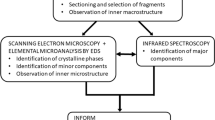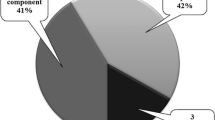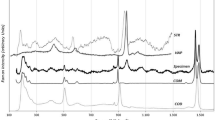Summary
10 urinary calculi have been qualitatively and quantitatively analysed using X-ray diffraction, infra-red, scanning electron microscopy, X-ray fluorescence, atomic absorption and density gradient procedures. Constituents and compositional features which often go undetected due to limitations in the particular analytical procedure being used, have been identified and a detailed picture of each stone's composition and structure has been obtained. In all cases at least two components were detected suggesting that the multiple technique approach might cast some doubt as to the existence of “pure” stones. Evidence for a continuous, non-sequential deposition mechanism has been detected. In addition, the usefulness of each technique in the analysis of urinary stones has been assessed and the multiple technique approach has been evaluated as a whole.
Similar content being viewed by others
References
Beeler M, Veith D, Morriss R, Biskind G (1964) Analysis of urinary calculus. Am J Clin Path 41:553
Bellanato J, Cifuentes Delatte L, Hidalgo A, Santos M (1973) Application of infrared spectroscopy to the study of renal stones. In: Cifuentes, L Rapado, A, Hodgkinson A (eds) Proc. Int. Symp. Renal Stone Res. Madrid 1972 S. Karger, Basel p 237
Carmona P, Bellanato J, Cifuentes-Delatte L (1980) Trimagnesium orthophosphate in renal claculi. Invest Urol 18:151
Gibson RI (1974) Descriptive human pathological mineralogy. Am Mineralogy, 59:1177
Herring LC (1962) Observations on the analysis of ten thousand urinary calculi. J Urol 88:545
Hodgkinson A (1971) A combined qualitative and quantitative procedure for the chemical analysis of urinary calculi. J Clin Pathol 24:147
Levinson A, Nosal M, Davidman M, Prien E (Sr.), Prien E (Jr.) Stevenson R (1978) Trace, elements in kidney stones from three areas in the United States. Invest Urol 15:270
Lonsdale K, Sutor DJ (1969) X-ray diffraction studies of urinary calculi. In: Hodgkinson A, Nordin B (eds) Renal Stone Research Symp., Leeds 1968. Churchill, London p 105
Lonsdale K, Sutor DJ, Wooley S (1968) Composition of urinary calculi by X-ray diffraction. Collected data from various localities. Br J Urol 40:33
Meyer S, Angino E (1977) The role of trace metals in calcium urolithiasis. Invest Urol 14:347
Norrish K, Hutton J (1969) An accurate X-ray spectrographic method for the analysis of a wide range of geological samples. Geochim Cosmochim Acta 33:431
Oliver LK, Sweet RV (1976) A system of interpretation of infrared spectra of calculi for routine use in the clinical laboratory. Clin Chim Acta 72:17
Rodgers AL (1981) Analysis of renal calculi by X-ray diffraction and electron microprobe — a comparison of two methods. Invest Urol 19:25
Rodgers A, Nassimbeni L, Mulder K, Mullins J (1981) Use of a density gradient column in the analysis of urinary calculi. Invest Urol 19:154
Rushton H, Spector M, Rodgers A, Magura C (1980) Crystal deposition in the renal tubules of hyperoxaluric and hypomagnesemic rats In: Iohari O (ed) Scanning Electron Microscop 1981, vol. III. I.I.T. Res. Instit., Chicago, p 387
Sagebiel W, Gjavotchanoff St (1978) Harnstein analyse heute. Das Ärztliche Laboratorium 24:21
Simmonds H, van Acker K, Cameron J, Snedden W (1976) The identification of 2,8-dihydroxyadenine, a new component of urinary stones. Biochem J 157:485
Spector M, Garden N, Rous S (1976) Ultrastructural features of human urinary calculi. In: Fleisch H, Robertson W, Smith L, Vahlensieck W (eds) Urolithiasis Research. Plenum Press, p 355
Spector M, Garden N, Rous S (1978) Ultrastructure and pathogenesis of human urinary calculi. Br J Urol 50:12
Spector M, Jameson L (1976) Scanning electron microscopy of urinary calculi. In: Johari O (ed) Scanning Electron Microscopy 1976, vol. II. I.I.T. Res. Instit., Chicago, p 307
Sutor DJ (1968) Difficulties in the identification of components of mixed urinary calculi using the X-ray powder method. Br of Urol XL-29
Sutor DJ, Scheidt S (1968) Identification standards for human urinary calculus components using crystallographic methods. Br J of Urol XL-29
Takasaki E (1971) An observation on the analysis of urinary calculi by infrared spectroscopy. Calcif Tissue Res 7:232
Westbury EJ (1974) Some observations on the quantitative analysis of over 1000 urinary calculi. Br J Urol 46:215
Westbury EJ, Omenogor P (1970) A quantitative approach to the analysis of renal calculi. J Med Lab Technol 27:462
Willis J, Erlank A, Gurney J, Theil R, Ahrens L. Major, minor and trace element data for some Apollo 11, 12, 14 and 15 samples. In: Heymann D (ed) Proc. Third Lunar Sci. Conf., Houston 1972. M.I.T. Press, p 1269 (Supplement to Geochim Cosmochim Acta 1972)
Author information
Authors and Affiliations
Rights and permissions
About this article
Cite this article
Rodgers, A.L., Nassimbeni, L.R. & Mulder, K.J. A multiple technique approach to the analysis of urinary calculi. Urol. Res. 10, 177–184 (1982). https://doi.org/10.1007/BF00255941
Accepted:
Issue Date:
DOI: https://doi.org/10.1007/BF00255941




